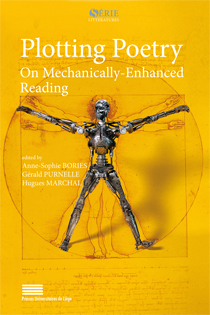
A.-S. Bories, G. Purnelle, H. Marchal (dir.), Plotting Poetry. On Mechanically-Enhanced Reading
Référence bibliographique : A.-S. Bories, G. Purnelle, H. Marchal (dir.), Plotting Poetry. On Mechanically-Enhanced Reading, Presses Universitaires de Liège, 2021. EAN13 : 9782875622808.
Plotting Poetry. On Mechanically-Enhanced Reading
Ouvrage édité par Anne-Sophie Bories, Hugues Marchal, Gérald Purnelle
Presses Universitaires de Liège, 2021
EAN: 9782875622808 - 161 p.
Scholars today are experimenting with a vast array of reading devices in order to explore texts anew, often blending, both on the technical and on the hermeneutical axes, traditional approaches and innovative computing tools, that collect textual features and detect trends not visible to a human eye as they exceed the span of our focus.
Our understanding of poetry is not left untouched by the revolution that computational analysis is bringing to the humanities.
Because of its intrinsic link to verse, poetry has been a very early object of statistical studies. Any careful examination of metres, rhymes, or caesuras is bound to generate large datasets, calling for the borrowing of methods from the exact sciences. Indeed, attempts at a mathematical evaluation of poetic styles largely predate the use of computers, and the methodological turn towards the use of new technologies has been generally well-received within the academic community. Still, is the mechanically enhanced, “nonhuman” reading of poems fruitful, or even legitimate? Must the literary scholar, whose object is a fundamentally “human” material, meet the burden of proof and possibly cast away intuitions? Conversely, can calculations account for the subtlety of our poetic experience? Is poeticity, in other words, to be found in the measurable sum of artfully assembled processes, or
does it escape all normalisation efforts?
Stemming from the group Plotting Poetry, a community of scholars of different language areas, working on different time periods and poetical genres, who have come together to share their findings and methods, this volume presents a rich sample of research endeavours in the field. It illustrates how a mechanically-enhanced reading can be put to the test, serve to pursue traditional hermeneutical questions, challenge certain assumptions about forms, reveal unsuspected thematic patterns, feed the approach of the literary historian, or open up new, unthought-of paths for our questionings. It is aimed both at specialists of either poetry or digital humanities, and at a broader readership curious to learn about computational approaches to poetry studies.
Sommaire / Table of contents
Anne-Sophie Bories, Introduction
Valérie Beaudouin, The Machine in the Garden of Meter and Rhythm
Elise Thorsen, David J. Birnbaum, Exploring Inexact Rhyme in Russian Verse
Natalie M. Houston, Exploring the Idiom of Victorian Rhyme Through Applied Historical Poetics
Peter Verhaar, Opening new patterns from new disorders: A Computational Analysis of the Poetry of Louis MacNeice
Éliane Delente, Richard Renault, Projet Anamètre : présentation, limites et avancées
Clara Martínez Cantón, Pablo Ruiz Fabo, Elena González-Blanco, Thierry Poibeau, Automatic Enjambment Detection as a New Source of Evidence in Spanish Versification
Isabelle Parkinson, A Poetics Defined in the Paratext
Muriel Louâpre, Hugues Marchal, Modelling and Visualizing the Evolution of 19th century French Scientific Poetry
Christophe Imperiali, Structures du vers dit